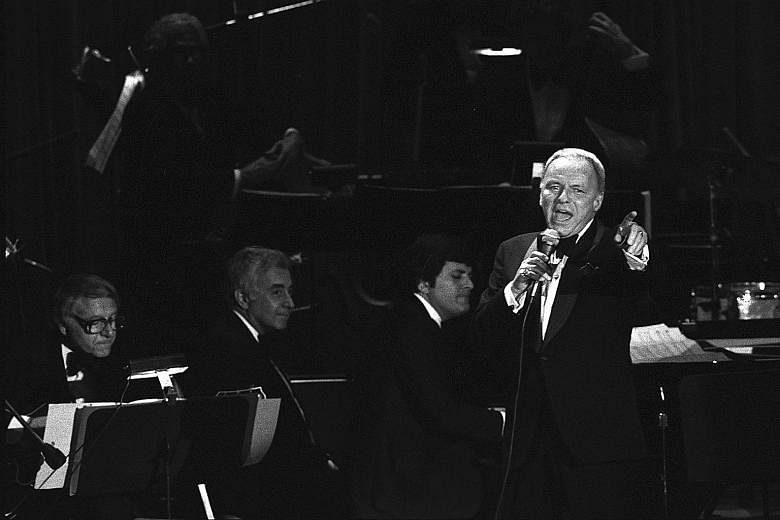NEW YORK • Frank Sinatra gave pop music a beating heart. Before Michael Jackson, Bob Dylan and Elvis Presley, there was Sinatra, the first modern pop superstar.
In the flood tide of centennial tributes (he was born on Dec 12, 1915), we celebrate the cool, ring- a-ding-ding Sinatra, whose most far-reaching accomplishment was infusing popular song with intimate personal emotion.
His union of the singer and the song was fortified by his proto- hipster image: a film-noir loner in a fedora with a cigarette and a drink; the flip side was the swinger bedding countless beautiful women and partying with his pals till dawn.
To borrow a title from Tom Wolfe, he was "a man in full". In Sinatra's intensely emotional interpretations, popular standards took on a new life by becoming quasi- autobiographical confessions.
The lyrics mattered as never before, foreshadowing the singer- songwriters of the next generation. Men didn't simply admire him. They wanted to be him, partly because he revised the definition of masculinity. He made self-pity a virtue.
Beginning with his sombre 1955 album of torch songs, In The Wee Small Hours, which some believe to be the greatest pop album ever made, Sinatra gave men licence to cry without shame. Sanctioned by a tough guy who consorted with mobsters, behaviour once synonymous with cowardice and weakness became noble suffering.
Before 1955, most popular music was dismissed as kitsch by the reigning culturati and distinctions between "high" and popular art were rigidly demarcated.
By treating popular standards as secular art songs dressed up in elegant, semi-classical and pop-jazz trappings by his most brilliant arranger Nelson Riddle, Sinatra began blurring the distinctions.
Almost single-handedly, he canonised the American songbook, a body of work created mostly for Broadway and movies that looms much larger than it might have had he not given it his passionate, sustained attention. It became a platform for philosophical ruminations on the meaning of it all.
Ella Fitzgerald also contributed to that preservation with her monumental "songbook" albums, but she was not emotionally invested in song lyrics.
Everything Sinatra recorded he made sound intensely, sometimes agonisingly, personal. Songs such as Night And Day, I've Got You Under My Skin, One For My Baby and Laura became his and no one else's.
When you think of them, it is likely Sinatra's voice you hear in your head.
You listen to the words and how he phrases them and often have the sense that they're coming spontaneously out of his mind and not from the pen of the song's lyricist, although in his concerts he was scrupulous to give writing and arranging credits.
With each re-recording, they expressed Sinatra's changing point of view over time and became the story of his life.
Other singers followed his lead and the interpretation of popular songs took on an entirely new significance.
Evolving technology conveniently and happily coincided with his ascendancy. Until the invention of the microphone, the pop crooner adopting a relaxed conversational tone couldn't have existed. The sound of Bing Crosby, Sinatra's most influential forerunner, evoked congeniality, nostalgia and the comforts of hearth and home - but not the joys and pains of love.
Sinatra used the microphone to convey an astounding intimacy infused with a tender eroticism that turned increasingly bitter as the years went by.
The best of his 1940s recordings, made mostly with arranger Axel Stordahl, are delicate musical valentines.
Listen to his Columbia recordings of My Melancholy Baby, Dream, I Don't Know Why, Oh! What It Seemed to Be, The Things We Did Last Summer, You're My Girl and If I Forget You and be transported. These performances have the devotional fervency of whispered prayers.
In the early 1950s, the skinny, blue-eyed boy from Hoboken, New Jersey, reinvented himself as a cosmopolitan performer with a purpose: to enshrine the songs of Berlin, Gershwin, Porter, Rodgers and Hart, Arlen and others once and for all.
At a time when novelties dominated mainstream pop, the rise of the long-playing record enabled Sinatra to create the first "concept" albums years before the term was coined around the time of The Beatles' Sgt. Pepper's Lonely Hearts Club Band.
The output of Sinatra, Fitzgerald, Peggy Lee, Sarah Vaughan, Billie Holiday, Lena Horne and Tony Bennett is synonymous with what many believe to be the golden age of the LP.
On their albums, romantic love - the subject of a majority of popular standards - was explored from an adult perspective.
In the 1950s, his once celestial baritone acquired a slightly rougher grain and he became the voice of experience.
His increasingly emphatic, upbeat syncopation spurred a full-scale swing revival - newly focused on the singer, instead of a bandleader - and heralded an age of individual self- expression that has only expanded and continued into the hip-hop era.
NEW YORK TIMES

